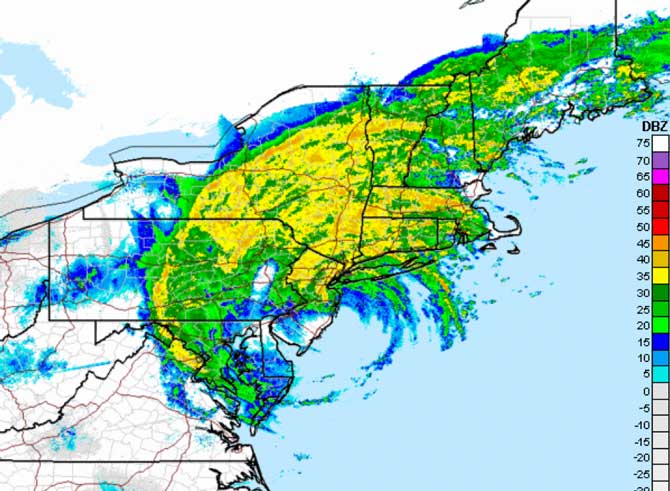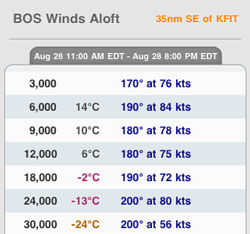
When Mike Freed locked up his business at the Ocean City, Md., airport the afternoon of Aug. 26, Hurricane Irene was on the doorstep and the town was under an evacuation order.
Freed placed Ocean Aviation’s two Cessna 172s and a newly acquired Piper Arrow in the hangar, turned out the lights, and hoped for the best. It was a tough call considering the storm’s predicted impact, and he fretted that perhaps he should have flown the aircraft out to safety.
Now the die was cast. Winds to 50 knots blasted the field as Freed monitored conditions remotely via the automated surface observing system (ASOS). He “wasn’t feeling too comfortable.” Then, at about 8 p.m. that evening, the ASOS failed.
Fast forward to Tuesday morning. Freed answered the phone at Ocean Aviation.
“We did well, thank you,” he told AOPA. “We were very fortunate. Everything here is just fine. The airport got away without any major damage,” he said. “When I got back in the morning, it was pretty dry.”
The word “fortunate” was on the lips of many airport communities after Hurricane Irene had come through.
 At the Dare County Regional Airport on the North Carolina coast, operations were back to normal Tuesday, and state and news helicopters were coming and going from the facility. The airport is not far from Hatteras Island, which suffered significant damage to homes and infrastructure, and was surveyed from the air by Gov. Bev Perdue after Irene had moved on.
At the Dare County Regional Airport on the North Carolina coast, operations were back to normal Tuesday, and state and news helicopters were coming and going from the facility. The airport is not far from Hatteras Island, which suffered significant damage to homes and infrastructure, and was surveyed from the air by Gov. Bev Perdue after Irene had moved on.
The airport was “open and going strong,” said aviation technician John Arendts, on the job Aug. 30 while still wondering what he was going to do about flooding in the downstairs part of his home. Arendts had also gone 30 hours without electricity, phone service, or cable television. He said he had heard of 92-knot winds in the area during the storm
In Norfolk, Va., “we’re up and running as usual,” said an employee of Landmark Aviation.
At New York’s Long Island MacArthur Airport in Islip, Aug. 26 was hectic as the airport community prepared and pilots had been urged to relocate for safety. Despite about three inches of rain and winds gusting in the 60s, “nothing horrible” occurred—and even the two aircraft whose owners had opted to keep them tied down outside came through unscathed, said Mindy Carlough of Mid-Island Air Service.
In Beverly, Mass., relieved and upbeat airport manager Bob Mezzetti said the only damage was a taxiway sign that blew over as Irene passed to the west of the Massachusetts coast.

“The wind and the rain kind of power-washed everything on the airport. It’s all clean as a whistle and the windsock held up,” he said.
In Fitchburg, Mass., Charley Valera, flight school operator and president of the Fitchburg Pilots Association, monitored surface winds of 50 to 70 knots, but no damage.
“I don’t have a lot to report other than the fact that we offered our services to the state and the local towns as needed,” he said. “Pilots associations are extremely important for this type of unity in a localized area,” he said.
Valera credited the volume of information available to pilots for minimizing problems. “Without that we’d have a mess,” Valera said. He added that an unexpected ice storm two years ago, and a “freak tornado” that struck Springfield, Mass., this spring took much heavier tolls in the area.
As it diminished somewhat to a tropical storm, Irene tracked inland during its march north through New England. In Concord, N.H., strong winds did no damage to aircraft tied down outside or hangared, said Lorraine Davidson of Concord Aviation. Across Merrimack County, however, residents were less fortunate, where about 2,000 remained without electricity, she said.
In northern Vermont, where many hard-hit communities faced flooding during and after the storm, gusty winds and five inches of rain didn’t cause damage at the Newport State Airport, elevation 930 feet above sea level. That despite its exposed location on a high knoll, said assistant airport manager Zach Gauvin.
The 50-miles-per-hour gusts were not as strong as forecast, and four aircraft tied down outside “didn’t move at all,” he said.
While airline flights by the thousands were grounded during the storm’s assault on the east coast, it may have been the cancellation of a GA flight from Ocean City, Md., that took the true measure of Hurricane Irene’s initial effects.
A daily newspaper had booked a Monday morning flight to survey damage—but when the time came, Mike Freed’s passenger was a no-show.
“There wasn’t enough damage,” he said. “They actually never called back.”



